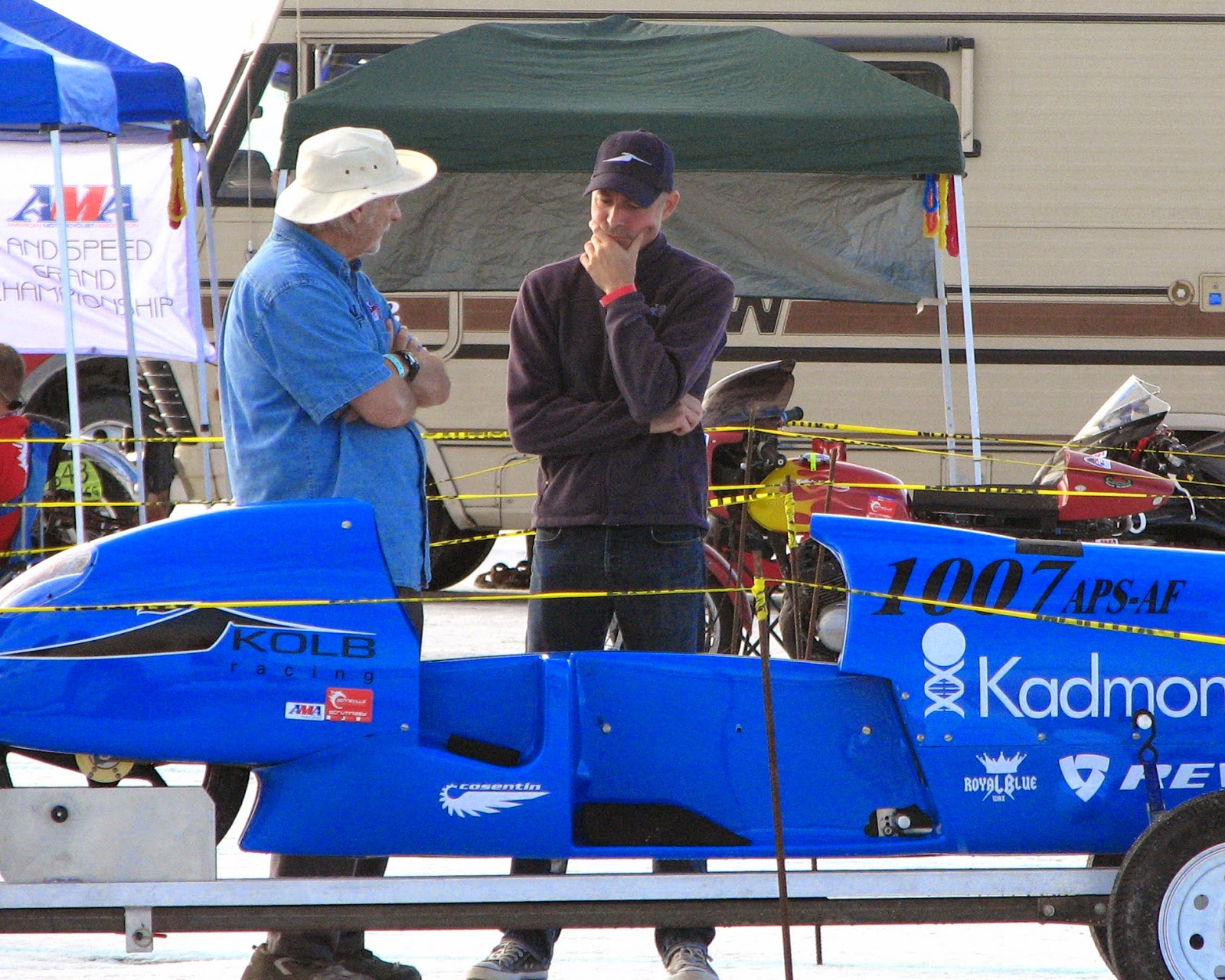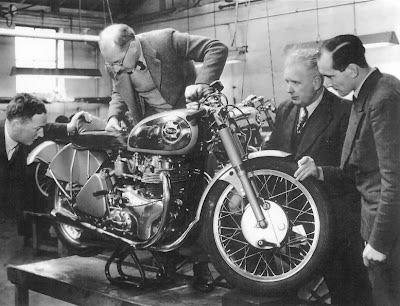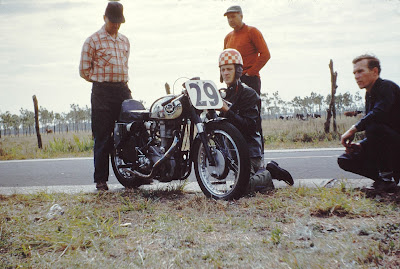(Article and photos protected under US copywright laws. No unautorized use or reproduction is permited.)
by Tom Rose
1946: America was on a fast track as the nation switched from war time military production to a booming peacetime economy. Sports were a major diversion for the hard working population. Millions flocked to the arenas and gathered around the television and radio for baseball, football, boxing and motor sports. At the Indianapolis 500 drivers like Bill Vukovich and Johnnie Parsons were national heroes. Bill Tuman was right there with the top sports figures of the day. As the owner, sponsor, mechanic, tuner and rider of the 44.72 cubic inch V-twin Indian Sport Scout Bill Tuman raced with and usually beat the legends of the sport.
 |
Bill Tuman, Bobby Hill, Ernie Beckman
"The Indian Wrecking Crew" |
Post WWII motorcycle racing in America played out on the many mile and half mile oval tracks around the country and road races at Daytona and Laconia. All this leading to one race on a one mile dirt track in the heartland location of Springfield, IL to determine the National Champion. It was the golden age of motorcycle racing. Harley-Davidson vs. Indian. The US manufactures vs. Great
Britain, Italian & German. Camaraderie and sportsmanship in the pits and all out, take no prisoners racing on the track. Great men and great machines. There in the middle of it all, on center stage of the racetracks of America was Bill Tuman and his buddies, Bobby Hill & Ernie Beckman, the Indian Wrecking Crew carrying the flag of a dieing company and doing it their way. This is their story.
Milwaukee, Wisconsin –September 8, 1953 - 9 AM Tuesday Morning: The directors of the Harley Davidson Motorcycle Company were seated around the large mahogany table in the boardroom on the 5th floor of the Juneau Avenue headquarters. They sipped coffee and puffed Cuban cigars. They were in a general jovial mood as they discussed the recent demise of their chief rival, The Indian Motorcycle Company (Hendree Manufacturing).
 |
#51 Tuman leads the pack at Des Moines on his way to his
1st AMA National victory. Paul Goldsmith #3 HD follows
closely but was unable to catch the Rockford Rocket. |
The mood changed quickly when William H. Davidson walked into the room and slammed a copy of the Milwaukee Sentinel sports section on the table. The headlines read “Bill Tuman rides an Indian to Victory at the Springfield Nationals”. Harley’s chief rival, Indian, had been struggling for several years. Indian had finally collapsed in bankruptcy. In spite of this a few hard core Indian racers sponsored by die hard Indian dealers were beating the socks off the Harley-Davidsons on the race track. The Indian racers had become known as the Indian Wrecking Crew of Ernie Beckman, Bobby Hill and Bill Tuman. The ultimate humiliation that set off Bill Davidson at the board meeting was Bill Truman’s victory the previous Labor Day week-end at the prestigious national championship Springfield Mile. Harley was celebrating its 50th anniversary. They had introduced the K model in 1952, a faster better handling motorcycle patterned after the race bikes of Europe and Great Britain. All this and they still had to contend with Indian winning races and championships!
In 1945 Bill Tuman had taken a job at the Navy Supply Depot in Oakland, CA. With WWII coming to an end that job was eliminated. Bill found himself far from his Rockford, IL home and needing work. There was a motorcycle shop across the street with a “motorcycle mechanic wanted” sign in the window. Bill was not a motorcycle mechanic but he had always been able to fix almost anything. He walked in the door and applied for the job. He was hired on the spot by the Hap Jones Indian shop. A short time later he built a race bike for Hap that won an important 100 mile race. Thus began a lifetime of 2 wheel excitement and excellence.
Even with his success in California, Bill longed for his Illinois home. Back in Rockford he picked up an Army surplus Indian. He worked through the winter in his unheated garage rebuilding it as a race bike.

He placed 2nd in his first race at Mendota, IL in 1946. He partnered with Joe Bishman who had been a pre war race champion. Bill found he could run with the top riders and was winning local races. He said to himself, “This is something that I can do!” His racing career was launched. He was so successful from the very beginning that he went from amateur status to the top expert classification the first year (completely skipping the usually required novice division). As he won races and attracted attention he gained sponsors and support. Erwin "Smitty" Smith, the Indian dealer in Rock Island, IL sponsored him and he received some support from other Indian dealers and the factory. It was nothing like the support of today’s factory race teams, just a few spare parts, a place to work on the bike, and a little expense money.

Bill was an excellent mechanic and race bike tuner. He made a few modifications to the Indian. He lowered the front axle and narrowed the front end. He discovered that the Big Base Indian engines were not balanced for the rigors of competitive racing. He added counterbalance weights to the fly wheel for greater reliability at high rpm race speeds. He had a side business building race engines for other riders. The Hess Machine Works in Rockford, IL allowed him to use their shop to manufacture parts. The Bill Tuman Indian engines were in great demand and remain so today.
Bill achieved phenomenal success in 1947, his second year as a racer, starting 46 races he had 41 firsts, 2 seconds and 3 thirds. Bill had bills to pay and a family to support. He limited his expenses by racing as close to home as possible. He found he could make more money this way than by traveling the country to the biggest national races. In 1948 and 1949 Bill continued to set a blazing pace, sometimes racing 7 times a week primarily in the Mid West, at local tracks, county and state fairs. He compiled 192 victories, 72 seconds 21 thirds. Despite his incredible string of victories he still had not won a “National”. However, that was soon to change.
On September 17th, 1950 Bill won the first of his five Nationals at Des Moines, Iowa. It was a hard fought victory competing against the nations’ best on the challenging ½ mile dirt track. Paul Goldsmith on a Harley-Davidson jumped to an early lead followed by Paul Albrecht also on a Harley and Bill close on his rear wheel. The riders traded places throughout the ten ½ mile laps with the intensity mounting with each lap. Bill finally took the lead with Albrecht coming on strong. But, Tuman held on for the win. He rode the only Indian in the race to victory!
A month later he again outran Albrecht and the Harley Davidson to capture his second National win at Reading, PA.
 |
Indian factory representative Vic Collard congratulates
Bill on another victory. |
Bills’ fame and popularity continued to grow. The fans and race clubs around the country voted Bill the coveted AMA Most Popular Rider award for 1950. He was a fierce competitor but at the same time always a gentleman and sportsman. An example came in 1948 at the 15 Mile National at Milwaukee. He was fighting wheel to wheel with Jimmy Chann on a Harley-Davidson. Chann went into a little wobble and almost fell. Tuman slowed and went wide into the loose dirt, dropping him back to 5th. A Harley-Davidson official was quoted on the incident “I was that sick I nearly cried. I had to get out of there as quick as possible. He had it in the bag and gave the race to another man just to be on the safe side and not cause an accident.”
The popular riders were men like Dick Klamfoth, Joe Leonard, Paul Goldsmith, Bobby Hill and Bill Tuman. They all had their following. The competition was keen among the riders and the manufactures. There were the American Harley-Davidson and Indians, the British BSAs, Triumphs, Nortons, Velocettes and Matchless, all fighting for supremacy. Thousands attended motorcycle races at local tracks, county and state fairs. The “Nationals” at tracks like Dodge City, Milwaukee, Daytona, and Des Moines drew even bigger crowds.
 |
Lined up for the 1953 Springfield Mile, #1 Booby Hill (Indian)
on the pole, #3 Joe Leonard (HD), Bill (#51)started in the far
outside position. |
The major motorcycle race at the time was Springfield. The top riders of the day met in September each year for The Springfield Mile, a series of elimination heat races which narrowed the top 50 or 60 riders to a final top 10. The elite 10 then raced for the prestigious National Championship trophy in a 25 mile shoot out on the famed 1 mile dirt track. The winner earned the right to carry the number 1 on his race bike the following season.
With all his success the big prize of the National Championship had eluded Bill. In fact Springfield almost seemed to be his hard luck track. Back in 1951 in the qualifying heat he needed a 5th place to make the final. He was running near the front when he was bumped in the final turn, he got hard on the throttle but was unable to make up the lost ground and finished 6th. Based on the heat race finish Bill was not eligible for the final. However, he was the designated alternate. If a qualifying rider could not make the start Bill could start as an alternate. When they lined up for the National only 9 riders came out so Bill was called out as the alternate. Harley rider Jimmy Chann made a big deal of it, protesting with the officials. “Tuman failed to qualify so he should not race.” He made a big stink so finally the officials said they would put it to a rider vote. There were 7 HD riders and 2 Indians-the vote was 7-2 Tuman should not race. Bill was mad and stormed off telling Chann that he was the worst sportsman that he ever knew. Jimmy smiled and said, “It’s easier to beat you with a vote than on the track.”

Now, in 1953 Bill was back at Springfield. He was running in the qualifying heat and it happened again, he was hit in the turn bending the number plate into the tire. On the last lap he was in last place, but given his experience in 1951 he was determined to make the field---as he opened the throttle there was no opening—he said to himself “I’m going anyway!” He busted through pushing past Klamfoth on the right and someone else on the left for a 5th place, qualifying for the National
Championship final. The 25 mile final was another hard fought battle on the famous 1 mile dirt oval. Imagine the excitement with the nations top riders lined up for an all out 25 laps for the biggest prize in motorcycle racing. The competitors included Bobby Hill on the inside poll, Paul Goldsmith, Joe Leonard, Everett Brashear, Ernie Beckman, Al Gunter. These top riders traded positions as the
tension and intensity mounted with every lap. After all he had been through just to qualify Bill was not to be denied in this championship final. As Gunter went wide on the BSA in the final lap Tuman powered past Leonard and Goldsmith for the checkered flag. It was a great victory for Bill, but, he always said that the qualifying heats at Springfield provided more excitement than the main final.
 |
The author hears some great racing stories visiting with
Bobby Hill & Bill Tuman at Daytona in March 2008 |
Throughout his career the Indian was his main ride, however he also raced Nortons, BSA, and Triumph. Bill retired in 1955 after a race in Pennsylvania. He pulled to the pits and walked over to BSA representative Walt Brown and asked him for a job. The next Monday he was on the road as a BSA factory rep in the mid west. After 3 years he opened his own dealership and eventually became a highly successful Honda dealer.
So that’s the way it was. Life in the fast groove, full throttle, living the American
Dream in the 50s.
(Article and photos protected under US copywright laws. No unautorized use or reproduction is permited. Thanks to Bill Tuman for sharing his racing experiences and photos. He is one of the great gentlemen of motor sports)


 Bill was an excellent mechanic and race bike tuner. He made a few modifications to the Indian. He lowered the front axle and narrowed the front end. He discovered that the Big Base Indian engines were not balanced for the rigors of competitive racing. He added counterbalance weights to the fly wheel for greater reliability at high rpm race speeds. He had a side business building race engines for other riders. The Hess Machine Works in Rockford, IL allowed him to use their shop to manufacture parts. The Bill Tuman Indian engines were in great demand and remain so today.
Bill was an excellent mechanic and race bike tuner. He made a few modifications to the Indian. He lowered the front axle and narrowed the front end. He discovered that the Big Base Indian engines were not balanced for the rigors of competitive racing. He added counterbalance weights to the fly wheel for greater reliability at high rpm race speeds. He had a side business building race engines for other riders. The Hess Machine Works in Rockford, IL allowed him to use their shop to manufacture parts. The Bill Tuman Indian engines were in great demand and remain so today. 




















































